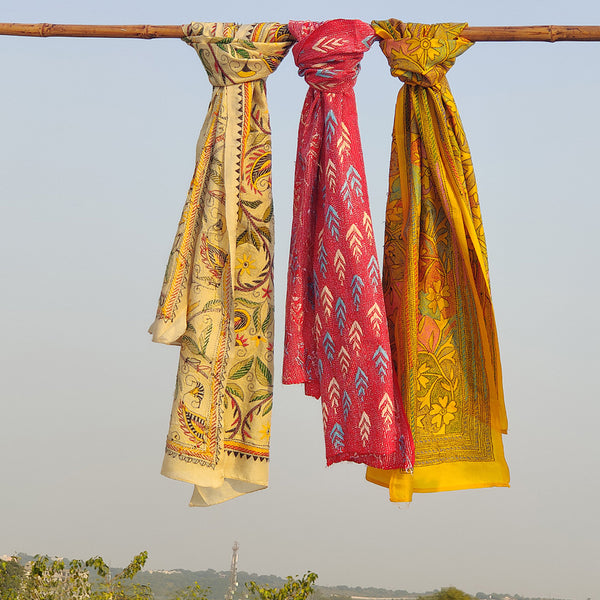Ajrakh is an Indian traditional form of block printing that is famous for its intricate geometric patterns, floral designs and beautiful earthy colours. In this blog, we shall unravel the glorious history of the Ajrakh printing of Gujarat and witness its evolution over time as it transformed into the famous Ajrakh print clothing, that has a dedicated fan base across the fashion circles.
History Of Ajrakh
The word Ajrakh is derived from an Arabic word called Azraq which means indigo. The origin of Ajrakh printing can be traced back to the Indus Valley Civilization. (1)
It is believed that the people from the Khatri community migrated from the region of Sindh in Pakistan to Gujarat and Rajasthan. While talking about the exact origin of Ajrakh printing, it is important to state that this technique was practised along the banks of the Sindhu River (Indus river) which came to be divided between Kutch in Rajasthan, Sindh in Pakistan and Marwar in Rajasthan. (2)

Ajrakh blocks | Maldhari wearing an Ajrakh shoulder cloth
Image Credit:- Khamir
What Is Ajrakh Printing
The most distinguished features of the Ajrakh printing of Gujarat are double side printings and the use of red and blue vegetable dyes.
Traditionally Ajrakh print clothing was used for making men’s garments such as lungis and turbans. The men in Kutch and Marwar continue to wear this as a part of their ceremonial attire for special occasions. (3) The process of Ajrakh printing has undergone some change over the years as the resist printing on one side of the fabric has changed into resist printing on both sides of the cloth.

Image Credit:- D'source
Process Of Ajrakh Printing
The process of Ajrakh printing in Gujarat is very intricate and highly laborious. Let us explore this process in greater detail:

image credit:- Khamir
- Firstly the fabric is washed thoroughly and subsequently beaten and rinsed. This smoothens the fabric for further stages of the printing process.
- After this, the fabric is put through a process known as Saaj. It involves embalming the fabric in a mixture of castor oil, soda ash or cow or goat dung. The fabric is dried out and smoothened for the next step.
- Then, the fabric is dyed in Harda which is a natural dye made from the fruit of the Myrobalan plant.
- The fabric is then left to dry, post which it is laid in tables for the craftsmen or Karigars to draw an outline of the design on the fabric. This outline is known as Rekh. The design is made using a mixture of natural gum and dye. The Rekh is resistant to indigo and the colour of Alizirin. It appears as a white line on the finished product.
- After this, a dye called kut is prepared using iron, jaggery, tamarind and millets. It is used for creating outlines within and over the intoin Rekh.
- Then, a fastening dye consisting of alum is used to fill in red details to the design.
- To make this dye resistant to indigo a paste called Pa is applied over it. This paste is made using clay, Dhawda gum and millet flour. Dried cow doing is sprinkled over pa to contain its spread.
- Finally, the fabric is dipped in a mixture containing lime, indigo, jaggery and mustard seeds. Once the cloth is taken out, it develops a blue colour once it oxidises.
- The fabric is then washed and dried a couple of times.
- For the red colour, the cloth is dipped in a solution made out of natural gum, dhawda flowers, alizarin and madder.
- The fabric is washed and dried repeatedly.
This culminates the process of creating a simple Ajrakh fabric. For added detail and more intricate, the fabric can be made to undergo multiple rounds of printing and dyeing. This process is also known as Meenakari.
Ajrakh print clothing embodies the charm of rich cultural heritage and impeccable craftsmanship. Therefore, it has transcended the barriers of time and continues to stay fashionable and relevant in the global fashion landscape.
Today Ajrakh is celebrated as an integral part of Indian fashion in the form of Ajrakh block print sarees, Ajrakh dupattas and Ajrakh Kurtis being worn by women. The brilliance of Ajrakh is also seen in men’s fashion with Ajrakh Shirts being women by men for festive occasions or casual gatherings.
We suggest you check out the gorgeous range of Ajrakh block printing on iTokri. While talking about Ajrakh in fashion, it is important to note that it is a super versatile fabric which can be used for making quilt patterns and women odhnis to hammocks and swaddle cloths. It is truly a traditional artistic wonder that shall continue to endear fashion enthusiasts for times to come.

Frequently Asked Questions On Ajrakh Print Clothing
Are these clothes machine-washable?
The prices of a Ajrakh printing is done using natural dyes and hence the fabric is averse to harsh detergents and bleaching agents. You must use mild cleaning agents to wash your Ajrakh clothes. It is always advisable to read the care instructions on the label to properly care for your garment.
Can I wear Ajrakh print fabrics in the summers?
Yes. Ajrakh printing is done on a variety of fabrics such as Cotton, Modal, Chanderi etc. Hence, you can easily opt for Ajrakh print clothing in summers.
Which are the popular fabrics used for ajrakh printing?
Cotton, Silk, and Chanderi are some of the most popular fabrics used for Ajrakh printing.
References:
- https://mapacademy.io/article/ajrakh/ (1)
- https://artsandculture.google.com/story/ajrakh-rhythm-of-blues-crafts-museum-delhi/WAWhhiXYIwIA8A?hl=en (2) (3)











Leave a comment (all fields required)